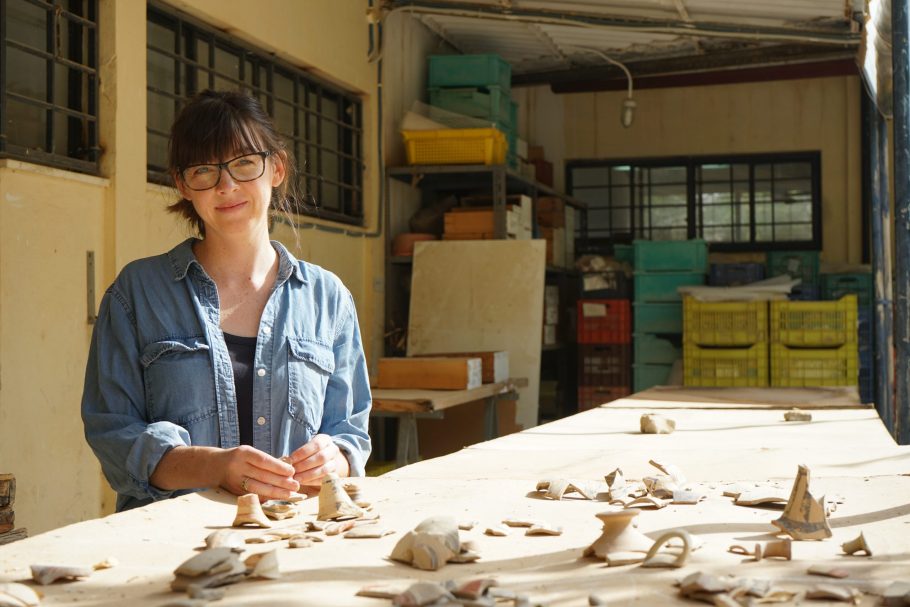Beyond the Walls of the Labyrinth
by Alice Crowe, PhD student, University of Cincinnati
As part of my current fellowship with the Archaeological Institute of America (Harriet and Leon Pomerance Fellow), I have the unique opportunity to spend the fall at the BSA Knossos Research Centre. While here, I am conducting macroscopic analysis of ceramic material recovered by BSA excavations in different parts of the Late Bronze Age settlement of Knossos, to be included in my doctoral dissertation at the University of Cincinnati (supervised by Eleni Hatzaki).
My project, tentatively entitled “Beyond the Walls of the Labyrinth: A Site-wide Perspective on Final Palatial and Postpalatial Knossos,” investigates how the town of Knossos transformed over the course of the site’s Final and Postpalatial phases, LM II-III (ca. 1430-1100 B.C.). This period of 300-odd years is characterized by profound changes in the Aegean: the end of “Minoan” dominance and the rise of the “Mycenaeans,” the construction and destruction of the Mainland palaces, and the formation of an integrated Aegean region. I examine the trajectory of the site of Knossos across this turbulent period, by integrating varied datasets and multiple scales of analysis.
Specifically, I study material from: 1. systematic excavations in the elite core of the site, 2. trial soundings conducted by the BSA in wide-ranging areas, and 3. surface survey data collected by the Knossos Urban Landscape Project (directed by Todd Whitelaw, Andonis Vasilakis, and Maria Bredaki). Using this evidence, I am carrying out focused studies of particular regions of the site, and building up to an examination of intra-site variances. A large-scale research project such as this one is only possible because of the impressive history of research in the Knossos Valley by the BSA and the Archaeological Service, one of the many reasons Knossos is unique among Aegean sites.
Currently, I am completing my study of the Hellenika region, located to the north of the palace. The area was the centre of the Greco-Roman city, and is thought to represent the northernmost sector of the Late Bronze Age town. So far, I have examined material from five disparate test trials conducted during restoration and infrastructure projects in the area, including ones underneath ancient buildings familiar to visitors to Knossos, such as the Villa Dionysus, and below contemporary structures beloved by scholars and students who has spent extensive time at the site, such as the BSA hostel (the “Taverna”).
The vast majority of artifacts collected by these projects are pottery sherds. Thus, most of my day-to-day work in the Stratigraphical Museum involves ceramic analysis. I search through the boxes of material recovered by the excavations, and identify sherds that date stylistically to the LM II-III period. While I adjust my methodologies according to the archaeological context from which the ceramics derive, in general, I sort and count the ceramics by shapes, fabrics, and surface treatment; calculate minimum quantities of vessels and degree of fragmentation; date the sherds to more specific ceramic phases within the broad LM II-III period; and record the information in my database.
Once I have completed my focused analyses of particular regions of the site, I will use the data to explore issues such as whether residents of Knossos’ peripheral neighbourhoods were consuming the same kinds of products as those living in the site’s central mansions, and if there are identifiable dividing principles in how the settlement is structured. I will also examine diachronic questions about the trajectory of the town over the course of the LM II-III period: did its extent contract and/or shift? If so, was the change gradual or punctuated, site-wide or localized? Finally, how does the size and organization of Knossos compare with those of contemporaneous Mycenaean settlements? In asking these questions, my objective is to reconstruct the settlement history of a major Mediterranean Late Bronze Age centre, and to provide insights into processes of acculturation, societal collapse, and deurbanization.
The Knossos Research Centre has been a fantastic environment for carrying out my research. The collections of the Stratigraphical Museum are unique, and Dr. Kostis Christakis, the Knossos Curator, has been exceptionally helpful and generous with his time. I have enjoyed seeing the fascinating assemblages that visiting scholars strew in the Museum’s courtyard, and learning from discussions about what they are working on. With a collaborative community of international scholars, an excellent library, and, of course, a location overtop of and surrounded by the remains of the Bronze Age town, the Knossos Research Centre has been an ideal location for carrying out my project.
I am grateful to the BSA for giving me permits to examine the material, to Dr. Christakis for his help throughout my time here, to Professor Todd Whitelaw for permission to study the KULP material and for his invaluable help and generosity throughout all stages of the project, and to the entire Knossos community for hosting me.
